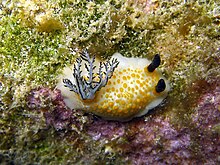
Rostanga is a genus of sea slugs in the family Discodorididae. Some sources, such as The Sea Slug Forum still classify Rostanga in the family Dorididae.

Chromodorididae, or chromodorids, are a taxonomic family of colourful sea slugs; dorid nudibranchs, marine gastropod mollusks in the superfamily Doridoidea. “Chromodorid nudibranchs are among the most gorgeously coloured of all animals.” The over 360 described species are primarily found in tropical and subtropical waters, as members of coral reef communities, specifically associated with their sponge prey. The chromodorids are the most speciose family of opisthobranchs. They range in size from <10mm to over 30 cm, although most species are approximately 15–30 mm in size.

Aldisa is a genus of sea slugs, dorid nudibranchs, marine gastropod molluscs in the family Cadlinidae.
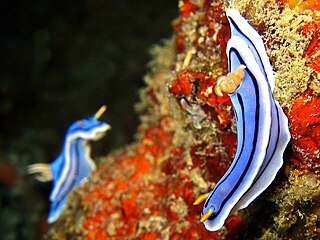
Chromodoris is a genus of very colourful sea slugs or dorid nudibranchs, marine gastropod molluscs, and the type genus of the family Chromodorididae. Within the genus Chromodoris, there are currently 101 classified species. Species within Chromodoris are commonly found in tropical and subtropical waters, living as members of reef communities and preying primarily on sponges. A molecular phylogeny of the family Chromodorididae resulted in this genus being restricted to a smaller number of species than formerly, most of which have longitudinal black lines on the mantle. Many former members of Chromodoris were transferred to Goniobranchus
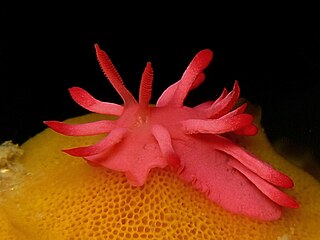
Okenia is a genus of colorful sea slugs, specifically of dorid nudibranchs, marine gastropod mollusks in the family Goniodorididae.
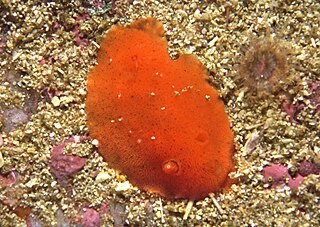
Discodorididae is a taxonomic family of sea slugs, specifically dorid nudibranchs, marine gastropod mollusks in the superfamily Doridoidea.
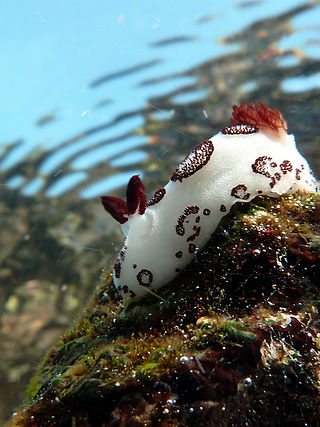
Jorunna is a genus of sea slugs, dorid nudibranchs, shell-less marine gastropod molluscs in the family Discodorididae.

The Facelinidae are a taxonomic family of colorful sea slugs. These are specifically aeolid nudibranchs. They are marine gastropod molluscs.

Doriopsilla is a genus of sea slugs, dorid nudibranchs, shell-less marine gastropod molluscs in the family Dendrodorididae.

Discodoris is a genus of sea slugs, dorid nudibranchs, shell-less marine gastropod molluscs in the family Discodorididae.

Peltodoris is a genus of sea slugs, dorid nudibranchs, shell-less marine gastropod molluscs in the family Discodorididae.
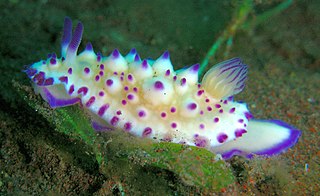
Mexichromis is a genus of colourful sea slugs, dorid nudibranchs, shell-less marine gastropod mollusks in the family Chromodorididae. Current synonymy follows a revision of Chromodorididae which used molecular phylogeny.
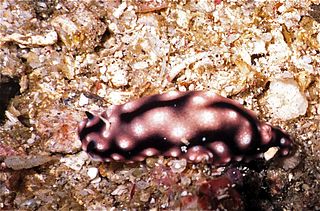
Paradoris is a genus of sea slugs, dorid nudibranchs, shell-less marine gastropod mollusks in the family Discodorididae.
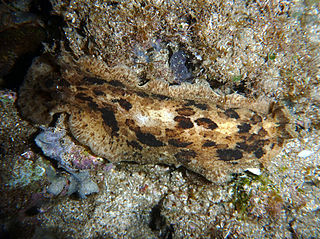
Sebadoris is a genus of sea slugs, dorid nudibranchs, shell-less marine gastropod molluscs in the family Discodorididae.

Thordisa is a genus of sea slugs, dorid nudibranchs, shell-less marine gastropod mollusks in the family Discodorididae.
Aporodoris millegrana is a species of sea slug, a dorid nudibranch, shell-less marine gastropod mollusk in the family Discodorididae.

Tayuva is a genus of sea slugs, dorid nudibranchs, shell-less marine gastropod mollusks in the family Discodorididae.
Aporodoris is a genus of sea slugs, dorid nudibranch, shell-less marine gastropod molluscs in the family Discorididae.

Felimare is a genus of sea slugs, dorid nudibranchs, shell-less marine gastropod molluscs in the subfamily Miamirinae of the family Chromodorididae.

Paradoris inversa is a species of sea slug, a dorid nudibranch, shell-less marine opisthobranch gastropod mollusks in the family Discodorididae.
